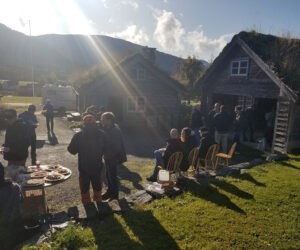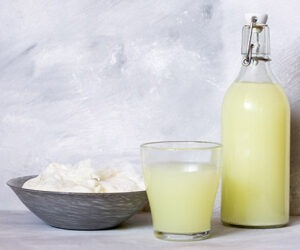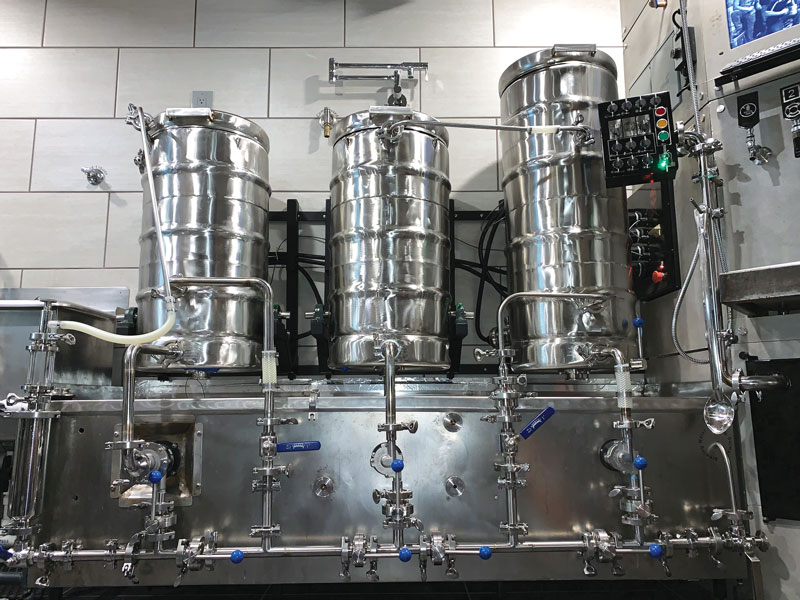All in the Neighborhood
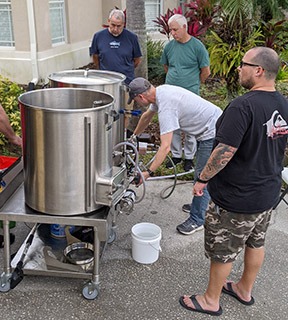
Fairgate Brewing’s story begins with my story.
I started to appreciate beer in the late 80s at the Horseshoe Pub in Hudson, Massachusetts, where they had 100 beers on tap — pretty amazing back then. My co-workers and I ran through the list more than once top to bottom. That is where I realized some beers belong at the top, and other ones belong at the bottom.
I moved a lot over the next couple of decades, mostly to places that did not have good beer selections. When I finally came to Florida just after 2000, the market was just starting to get going but it was still hard to find even a decent bottle shop.
By now my brother had been homebrewing for several years and winning competitions, and my sister had mastered meadmaking. But I was always living in small places and I could not really follow suit.
Fast forward a couple more years and around 2007 I got a Mr. Beer kit and made my first batch of hefeweizen. It turned out OK, but I wanted to make it better. It’s fair to say that from that first brewing experience I was hooked.
In short order I got the gear for 5-gallon (19-L) partial extract batches on the stove and quickly transitioned to full-volume boils using propane and really started making progress towards consistently good beer. In 2015 I moved to a new area and a great neighborhood called Fairgate with great neighbors and a very social environment. I immediately had brewing partners and drinking buddies who were really interested in the process and wanted to help and learn more about brewing.

Brian and Gary were always pestering me to teach them, show them, let them do the work, while pushing toward what was next. Other neighbors also joined in periodically. With a growing audience enjoying our beer regularly, it was time to scale production up. I moved to 10-gallon (38-L) all-grain batches, and I built a 6-tap keezer.
As time passed and more people sampled the beer, lots of folks started bugging me about going pro. It was a nice dream, yet always felt out of reach. But I was really enjoying brewing bigger all-grain batches. As more of my neighbors and friends joined in the fun, it was clear that I would once again need to increase batch sizes to accommodate. As more of my neighbors got taps (we now have more than 20 taps between us that we fill) and more friends started participating, it became a real community event on brew day. We might have 15 or 20 people show up, sometimes bringing their kids to play with mine, and we began making a day of it. Same thing with kegging. Over time, new folks moved into the neighborhood, and others started becoming regulars at the events.
But to scale up the gear to accommodate, we needed more money than I was willing to spend by myself on a hobby. Hit with this reality, a couple of the guys began asking the questions: “Just how much money?” and “What could we get for it?” and “Should we target gear that could grow or even fit into a future professional venture?”
A Community Affair
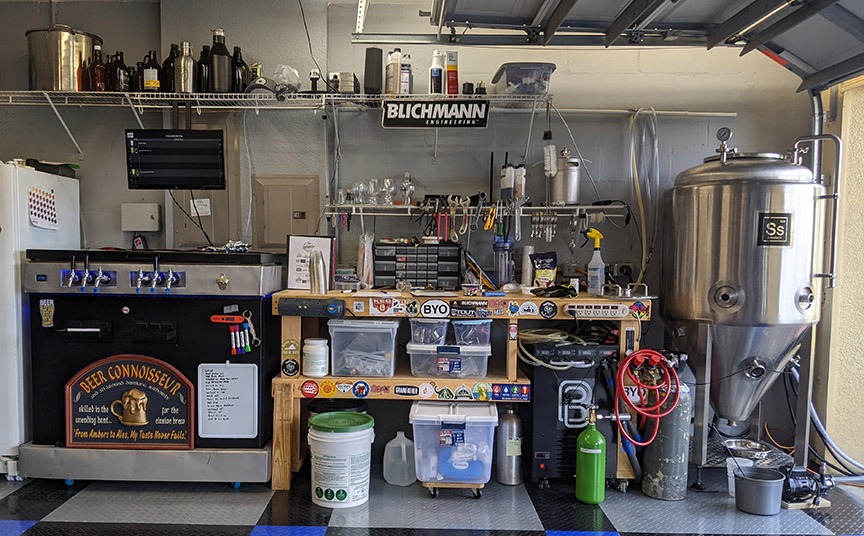
It soon became obvious I was not in this alone. So off we went trying to figure out what was the best gear to get, what it would cost, and who was willing to share in the investment. It was at this point we started having business meetings and eight of us became core members (myself, Brian Donley, Ken Sierra, Guy Tortorici, Jon Tomsu, Joe Abad-Santos, Rob Cirillo, and Joe Barravecchio). We were having a blast — we created a website, Facebook page, grabbed a domain, registered an LLC, and started creating logos and designs (in part for fun, and in part just in case this venture did turn into more than a hobby). There was plenty of early excitement. We drafted up documents about what it meant to be part of the community brew group, how to participate, and laid out details of the financial investments (more details about this are in the final section of this story “Setting Up the Partnership”, below). Over the course of a few business meetings we started down the path to Fairgate Brewing, a non-commercial neighborhood brewing collaboration.
One of the questions we had to answer was about the legality to brew as much beer as we began talking about. In a quest for that answer we spent significant time researching — and made a point to really understand — regulations, taxes, and licensing at federal, state, and local levels as best we could. Understanding the boundaries significantly informed what we chose to do or not do. We also brought questions that were answered by industry attorneys at a BYO NanoCon Online event, which was really helpful. We learned a lot and have been diligent about managing to appropriate thresholds and behavior. We are conscious about brewing frequency and batch sizes so we stay below the federal government’s 200 gallons (757 L) per year threshold allowed for a married household. And we never sell any product nor invite any offerings or tips. To get licensed in our location is a big step that requires effort and investment we aren’t willing to make at this time (although it is an option others may wish to consider, even if they don’t plan to sell their beer). Lastly on this subject, we have an agreement that if you want the beer you have to be part of the brewing process, which most people want to do anyway and which again supports the community approach.
The next area where we spent a great deal of research was on the equipment that best fit what we were looking to achieve. We ended up buying a customized one-barrel (31-gallon/117-L) two-vessel electric Blichmann BrewEasy™ Pro system using the BrewCommander™ controller. The Blichmann Pro guys were awesome to work with and helped customize the mash tun with a manway. At 100+ pounds (45+ kg) of dry grain in a recipe, you ain’t lifting that out — so a mash tun doorway and a shovel were a priority! We coupled that with a two-barrel jacketed Ss Brewtech Unitank, grabbed a BrewBuilt IceMaster MAX 4 glycol chiller, and layered in all the supporting gear. The brewery is in a dedicated bay of my garage. We plumbed dedicated water, ran a pair of additional 240 GFCI lines and some additional 120 GFCI lines, and added tables and shelving so that everything had a place. For those wondering, all-in was a little less than $15,000. Split eight ways, it was manageable.

But great gear does not necessarily make great beer — we needed to learn a bunch about the new gear as well as the scale and the process. There were changes we needed to consider and opportunities to leverage. We jumped at the opportunity to attend BYO NanoCon Online in 2020 and picked up great info there (and have been attending annually, since). So much good stuff. In 2019 we also signed up for the BYO Boot Camps in Denver, Colorado for spring 2020. Well, COVID changed those plans, but subsequently a couple of us made it to the re-scheduled November 2021 Boot Camp in Denver. Ken went down the start-up track and I went to hone my brewing craft. It was a fantastic experience! I loved getting to meet and learn from folks like John Blichmann, John Palmer, Gordon Strong, and many others. Great people, great content, and loads of inspiration!
The Brew Days
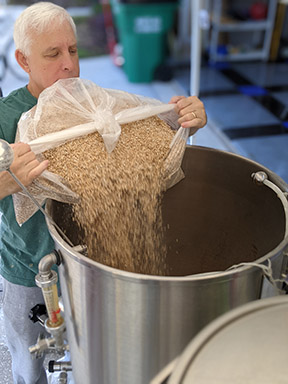
It is always a joint effort when we brew. We make a Google poll and vote on what type of beer we will make for each brew session. Folks sign up for how much they want and contribute pro-rated to the purchase of the ingredients. I will assemble a recipe and then a bunch of us head out to our local homebrew supply shop, Southern Brewing & Winemaking in Tampa, Florida. We have a few of their beers while we select the ingredients and talk through the brew day. Then we decide who will be lead brewer for the day. I will usually do a walk-through in advance with the lead brewer – reviewing our gear, our procedure and manual, as well as the recipe and process for the day. We all agreed that we would take turns in different brew day roles to keep people involved and prevent anyone from being “stuck” in a role. “Why do I always have to clean the mash tun!?” is not a conversation anybody wants to have.
With gear this big, it is always easier with many people, and sometimes requires more than one. The lead brewer controls the process and timing and assigns jobs. Setting up and assembling the gear requires a couple people. We usually brew under a large tent so that’s gotta go up. Tables, chairs, food, cups, trashcans — basically we set up for a block party. Milling over 100 lbs. (45 kg) of grain can take an hour, mashing in can take three people, shoveling out the mash tun and transporting the spent grain is 3–4 people. Lifting the 55-gallon (210-L) empty mash tun just to go hose it out is two people. Cleanup at this scale must be many hands in parallel with everything else. A Unitank that’s over 6-feet (1.8-m) tall doesn’t move, so it’s all CIP (clean in place) to clean/sanitize so that means extra work with pumps and hoses. One thing I always appreciate is the number of times people ask, “What can I do?” Guests are always excited to get involved, learn, do the heavy lifting, cleaning, etc. It’s a good time for everyone — and in the end the result is beer, so we all win!
A couple of days later we brew. Usually, a core group of 3–4 of us get started a little earlier and then other brew buddies and their families and friends will cycle in and out over the day, often bringing food and good stories with them.
The beers always have a way of naming themselves, generally from some little quirk related to the brew day or kegging day or something somebody said, and bam — just like that the beer earns its name. Examples include Hot and Dirty Belgian Blonde, Germ-In Stout, and others. It is always fun.
After brewing, we use a Tilt hydrometer and TiltPi setup so everyone can follow along fermentation progress on the web and on the brewery monitor over the keezer. I also use RaspberryPints on the monitor to track and display kegs, beers, and taps. When it gets close to finishing fermentation, we usually set up the spunding valve and capture the last few points of gravity to naturally carbonate. Then we add a little more CO2 as we cold crash it to clarify.
Kegging days are always fun because we can sample straight from the Unitank to get started. Folks who signed up for some of the batch show up with their kegs and growlers. Inevitably we end up needing to run a cleaning cycle on some of these that were not well cared for. Then we sanitize and fill before folks take their kegs back home to their own taps to enjoy. Cleaning up after 30, 40, or 50 gallons (115, 150, or 190 L) of beer is definitely a real community effort, but after kegging and sampling it seems to go quickly.
Closing out 2021, with COVID and everything else, we got distracted and did not make our usual fall beer — either my Pumpkin Pie Ale or the crowd-favorite Smoked Pumpkin Porter. We just missed the window of timing. So, after Thanksgiving we took a run at a Gingerbread Stout. It took a long time to dial in the right spice / ingredient mix to get it where we wanted it but in the end all the work was worth it and the beer received glowing reviews. We kegged it on New Year’s Eve, and since it was cold crashed and carbonated in the Unitank it was great to ring in the New Year with. We are happy to share that (scaled down) recipe below.
From the beginning, Fairgate Brewing was founded on the principles of community, friendship, and fun. Coming out of the BYO Boot Camp 3-day brewery start-up track we answered the question “can we do it (go pro)” with a “yes.” But, at this point, we are not ready, and we are unwilling to risk sacrificing the founding principles we hold so dear. So, for the immediate future we will continue to invite people to come and enjoy the experience and the products that we call Fairgate Brewing — our friends & family neighborhood brewery partnership in Wesley Chapel, Florida. Who knows, maybe some day we’ll expand beyond the neighborhood.
Setting Up the Partnership

When we looked at forming a partnership, we wrote down a few things that helped keep us on track. I’m sharing the main areas we focused on here in case other homebrewers may consider such a partnership with friends and neighbors too. After all, while the homebrewing hobby is all about fun and good beer, when there are significant investments shared it makes sense to hammer out the details from the start. Our brewery charter includes:
• Clarifying our WHY — Why were we doing this, and were we all on board? And how would we know if we started to stray. Purpose, vision, mission, goals, etc.
• Describing our WHAT — What we did and did not want to do or be. This included future aspirations. What we are now and what we might be in the future (pro) and being clear about making the decision to go forward. Discuss and document what being part of the original partnership means for a potential commercial venture going forward. Even if we never go that route, we thought it was important to clarify and write it down so everyone knew what was or was not available, to whom, and when.
• Assigning shares and voting rights — Who was in, who was not, who had a vote. Describing how a new member could be added and how and when a member could exit. If the membership changed, what happened to the shares and the voting rights. This even included transferring shares to beneficiaries as well as someone abandoning the group or moving out of the area, right through to dissolving the partnership and what would happen to the gear. Clarifying the exit situations at the beginning was a little challenging but well worth the peace of mind later and may eliminate future conflict.
• What actions needed votes and who could do what without votes – We also nailed down what it meant to “buy-in” financially, where the money was going, how the spending was shared and logged, who could spend, and when did the spending need approval by the partnership.
• Roles and responsibilities – These almost fell into place with people volunteering for titles/responsibilities they were passionate about and possessed the required skills. Marketing/branding, communication/social media, sales, brewing, finance, and our rotating brew day roles.
• What is owned by the partnership vs. individually — Everything from equipment to intellectual property, recipes, names, and ideas.
• Laying out the foundation of a business plan — Started the lengthy list of to-dos, to-decide, to-learn, and to-partner with.
• https://fairgatebrewing.com/
• https://www.facebook.com/fairgatebrewing
Fairgate Gingerbread Stout
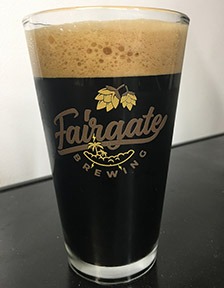
(5 gallons/19 L, all-grain)
OG = 1.088 FG = 1.021
IBU = 51 SRM = 50 ABV = 9%
Ingredients
8.8 lbs. (4 kg) North American 2-row malt
2.1 lbs. (0.95 kg) Munich malt
13 oz. (370 g) flaked oats
13 oz. (370 g) Carapils® (dextrin) malt
1.1 lbs. (0.5 kg) black barley (500 °L)
11 oz. (310 g) crystal malt (60 °L)
8.5 oz. (240 g) Special B malt
8 oz. (230 g) crystal malt (40 °L)
5.5 oz. (155 g) crystal malt (120 °L)
2 lbs. (0.9 kg) molasses (60 min.)
18.2 AAU Magnum hops (60 min.) (1.3 oz./37 g at 14% alpha acids)
1 Whirlfloc tablet (15 min.)
1 tsp. yeast nutrient (15 min.)
spice tincture #1 (10 min.)
spice tincture #2 (secondary)
Wyeast 1318 (London Ale III), White Labs WLP066 (London Fog), or LalBrew Verdant IPA yeast
2⁄3 cup corn sugar (if priming)
Spice tincture ingredients
6 g vanilla beans, Grade B (split scraped, sectioned)
60 g ginger root (coarse grind with skin in food processor)
8 whole allspice berries (coarse grind)
2 tsp. cinnamon stick (coarse grind)
2 whole cloves (coarse grind)
1 tsp. whole nutmeg (coarse grind)
Vodka to cover
Step by Step
Create spice tincture five days prior to brewing. To do this, add spices to a glass jar, cover with vodka, screw on lid, shake to mix thoroughly. This tincture will be divided into two equal amounts and account for both tincture additions (or split the ingredients into two jars from the start and make two separate tinctures).
On brew day, starting with reverse osmosis water, add salts toward a dark brown beer profile — sulfate:chloride ratio of about 0.7. Mash in pale, Munich, flaked oats, and Carapils® via underlet to stabilize temperature at 150 °F (66 °C), then wait 30 minutes. Add remaining grains to top of mash after 30 minutes, shallow mix these grains into the mash. Vorlauf for 30 minutes then transfer wort to boil kettle and boil. Add molasses, hops, kettle fining, and yeast nutrient per ingredients list. For the first spice tincture — add the spices to a strainer bag, place it into boil at 10 minutes remaining. Do not discard the vodka. Pour in vodka at flameout. Whirlpool for 15 minutes.
Chill the wort and transfer to fermenter. Pitch yeast at 68 °F (20 °C) and hold temperature for the duration of active fermentation. After one week drop yeast cone (or rack to secondary) and add second tincture (both the spices and vodka) into fermenter. Let stand for at least one week. Force carbonate to 2.3 v/v or bottle and prime with corn sugar.
Partial mash option: Replace the pale malt with 6.6 lbs. (3 kg) of light liquid malt extract and reduce the Munich malt to 1.5 lbs. (0.68 kg). The steps will nearly parallel the all-grain instructions. Place the Munich malt, flaked oats, and Carapils® in a muslin bag and steep in 2 gallons (7.6 L) of water at 150 °F (66 °C) for 30 minutes. Place the remaining grains in a separate bag and add these grains for the remaining 30 minutes of the mash. Place both bags in a large colander and wash with 1.5 gallons (5.7 L) of hot water. While heat is turned off, stir the liquid malt extract and molasses into the wort. Stir until fully dissolved then top up to 6 gallons (23 L) and bring the wort up to a boil.
Follow the remainder of the all-grain recipe instructions.

